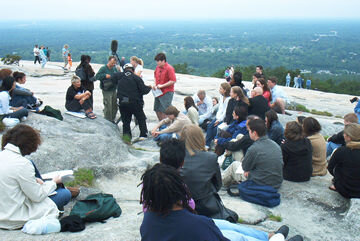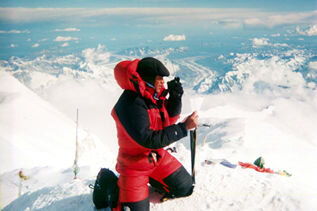POETRY ON THE PEAKS
Photo: Mt. Katahdin, USA
The UN has proclaimed 2002 as the International Year of Mountains (IYM) to increase international awareness of the global importance of mountain ecosystems. Poetry on the Peaks celebrated the relationship between humanity to nature through poetry by setting-up poetry readings on as many of the mountains in the world and corresponding cities. The program increased awareness of pressing environmental and social issues. The program was organized by Rattapallax.
Photo right: Stone Mountain, Georgia, USA (April 27, 2002)
The Seven Summits
(The highest peaks on the seven continents)
Aconcagua, Argentina (January 23, 2002)
Carstensz Pyramid, Irian Jaya, Indonesia
Denali, Alaska, USA (June 28, 2002)
Mt. Everest, Nepal (May 12, 2002)
Mount Kilimanjaro, Tanzania, Africa
Vinson Massif, Antarctica (January 19, 2002)
Mt. Elbrus, Russia (July 30, 2002)
Other mountain readings
Mt. Rainier, Washington, USA (July 22, 2002)
Mt. Fuji, Japan (July 30, 2002)
Stone Mountain, Georgia, USA (April 27, 2002)
Mt. Marcy, New York, USA (July 30, 2002)
Saint Elias Mountains, Canada (May 20-24, 2002)
Mt. Bonnell, Texas, USA (April 7, 2002)
Ardèche Mounts, France (April 20, 2002)
Bear Mountain, New York, USA (May 18, 2002)
Mt. Whitney, California, USA (April 11-14, 2002)
Mt. Jiri and Mt. Mani, Korea (May 18, 2002)
Mt. Gardener, Canada (April 21, 2002)
Mt. San Jacinto, USA (March 17, 2002)
Mt. Wellington, Tasmania (March 22 & 24, 2002)
Mt. Bondone, Italy (March 18, 2002)
Mt. Bucegi & Mt. Nemira, Romania (May 11, 2002)
Mt. Irvine, Australia (March 17, 2002)
Mt. Esja & Snaefellsjokull, Iceland (July 2 & 5, 2002)
Nose Mountain, Canada (July 28, 2002)
Island Peaks, Nepal (May 12, 2002)
Mt. Battie, USA (October 10, 2002)
Mt. Katahdin, USA (October 4-6, 2002)
NEW YORK TIMES: Poetry on Mountaintops, or at Least Hilltops
By JAMES GORMAN / March 8, 2002–THE OUTSIDER.
Think globally, climb locally. I think this should be the motto of the United Nations International Year of Mountains, which is 2002, for anyone who didn’t receive news of the official kickoff in Rome on Feb. 15.
If you missed it, that’s understandable because this particular celebratory year is one among many that the United Nations has declared — so many, in fact, that one could construct an entire new astrological system based on them. Infants born in, say, the International Year of Older Persons (1999) might mature late. Those who first encountered life in the International Year of Volunteers (2001) would be busybodies all their lives.
The system would be complicated, however, by the addiction of the United Nations bureaucracy to designated years. For instance, I guess the Food and Agriculture Organization had dibs on mountains, so the General Assembly got stuck with declaring 2002 the International Year of Ecotourism. And Unesco celebrated 2001 as the International Year of Dialogue Among Civilizations.
That went well.
I resist most of these designations. I take my years more personally. I may, in my mind, remember the Year of Head Lice, which, as I recall, was followed by the Second Year in a Row of Head Lice. But I don’t create logos and have events.
Not that the attempt to concentrate attention on mountain environments and mountain peoples is not virtuous and praiseworthy. It just loses some of its oomph among all the other Years-Of. It does, however, have a great poetry project.
A group called Dialogue Through Poetry is coordinating worldwide readings of poetry on mountaintops, called Poetry on the Peaks. There have been or will be readings on the seven summits — the highest peak on each continent. Readings will be done on Denali (a k a Mount McKinley) and Rainier and other massive mountains. But there will also be events on lesser heights. A reading of Walt Whitman will be done at his memorial on Bear Mountain in New York State, for instance. And a group will climb Stone Mountain in Georgia to listen to the words of the Rev. Dr. Martin Luther King Jr.:
Let freedom ring from Stone Mountain of Georgia.
Let freedom ring from
Lookout Mountain of Tennessee.
Let freedom ring from every hill and molehill of Mississippi,
from every mountainside, let freedom ring!
If that doesn’t deserve to be read from a mountaintop, I don’t know what does. The poetry selected to be read is of all sorts, lyric, quiet, loud, full of exhortation, contemplative. The shortest bit of poetry was read Jan. 19 at the top of the Vinson Massif in Antarctica. I would have picked something short to read if I were anywhere in Antarctica. The verses came from William Blake:
Great things are done when men and mountains meet;
This is not done by jostling in the street.
In the face of Poetry on the Peaks, I feel a distinct weakening of what I tend to think of as my healthy skepticism and other people sometimes regard as “a negative attitude.” Mountains and poetry belong together, and I’m in favor of this joint celebration of both of them, even if it is connected to the United Nations’ unstoppable “Year-Of” generator. (In fact, Dialogue Through Poetry got its start a year ago as part of the Dialogue Among Civilizations.)
Naturally the plan for the readings made me think about what poem I would choose, and what mountain. The poem came quickly, “Rock and Hawk” by Robinson Jeffers. I read it for the first time only a few months ago when a reader sent it to me.
As to the mountain, there were already readings on two New York peaks, Bear Mountain and Mount Marcy. I decided I should claim what I think of as the neighborhood peak, Hook Mountain, in Upper Nyack, N.Y., otherwise known simply as the Hook.
It’s not really a mountain in the way that Denali or Everest is. The summit is just 736 feet above sea level, and geologically it is an extension of the Palisades that rise above the west shore of the Hudson farther south. And its face: the cliffs were quarried for basalt in the late 1800’s.
If fact, the rock was so chopped up that even that long ago, the quarrying sparked efforts at preservation. Eventually the Hook was saved, bought by the Palisades Interstate Park Commission. The first part of the purchase from the quarry companies was in 1911. In the ensuing years, more land was bought.
Photo top: Denali, Alaska, USA (June 28, 2002)
But then, in the 1920’s, according to “Palisades: 100,000 Acres in 100 Years,” by Robert O. Binneweis, the park commission itself proposed to raise money by quarrying the Hook to such an extent that it would have actually removed the mountain. The rationale was that the Hook had already been defaced, so why not finish the job, make a nice road along the Hudson, create more usable park land and earn money for other parks at the same time. The plan did not succeed.
So the Hook still stands, scarred, with dangerous cliff-side trails and a rounded peak that offers views of the Hudson south to the Tappan Zee Bridge and beyond. It is popular with hawk watchers during fall migrations, and it attracts hikers and mountain bikers as well.
I went up the shortest way, a 15- minute uphill walk, on a bright winter morning. This is not the kind of mountain you take oxygen up; the summit is more suited to a thermos of coffee and a scone.
Even so, the temperature was in the low 30’s, the wind was blowing, and it was exhilarating to stand on the top of the hill, alone, with the reflected light on the river so bright it was hard to look at.
Small or not, I think this is the kind of mountain most people have in their backyards. Only a tiny group of people will make it to the higher peaks this year, but anyone can hike up the closest hill that has “mountain” in its name and take a book of poetry. If you have the time, money and lungs to climb Mount Rainier, more power to you. If not, think big, climb small.
I think you will still encounter some of the feeling that mountains inspire, the feeling found in “Rock and Hawk” as Jeffers describes:
This gray rock, standing tall
On the headland, where the sea- wind
Lets no tree grow.
And, with any luck, a small hill and a little bit of poetry will inspire you to want more of both. Just finding out about Poetry on the Peaks inspired me to read more of Jeffers’s poetry and more about him as well as to visit the Hook. I picked up “The Selected Poetry of Robinson Jeffers,” a book published last year, from the library and found a man who was not fond of humanity but dearly loved hawks and rocks.
He wrote, in an introduction to one of his books, that his poetry was “based on a recognition of the astonishing beauty of things and their living wholeness, and on a rational acceptance of the fact that mankind is neither central nor important in the universe.”
I particularly loved the conclusion of “Rock and Hawk,” when Jeffers describes the:
Mysticism of stone,
Which failure cannot cast down
Nor success make proud.
That is the way I like to think of mountains: as immune to human sentiment, as existing apart from the frenzy of human activity.
The problem was that I had also read about the history of the Hook, including the unsuccessful plan to cut it down and smooth over the stump. Jeffers reveled in the permanence and immutability of rock. That is really what I wanted to savor, more than the elevation and the view.
Instead, here was a case where the mountain itself was as fragile and as much at the mercy of humanity’s whims as the environments and cultures of the grander peaks.
Jeffers’s poems sometimes seem to long for people to vanish from the earth as a kind of relief for the sea and rocks. In “Carmel Point,” he writes:
. . . It knows the people are a tide
That swells and in time will ebb, and all
Their works dissolve.
No doubt. The question is how much they will quarry along the way.
Lofty Words.
Poetry on the Peaks is coordinating readings on mountains around the world this year. In New York State there will be a reading of parts of Walt Whitman’s “Song of the Open Road” at Bear Mountain on May 18 and a reading of “Mountain” by Louise Glück on Mount Marcy on July 27 and 28.


